August 1970 - Vol. 13 No. 8

Features
The allocation of computer resources—is pricing the answer?
The widespread use of complex third generation computing systems has led to a much broader concern about the means by which the resources of these systems are allocated among the user community. One means that is suggested more and more frequently is a pricing procedure. In this paper the manner in which one would like to allocate computing resources is considered, and then the extent to which a pricing mechanism fits this mold is discussed. Inasmuch as pricing must serve as a rationing mechanism at times, consideration is given to the means by which prices can be adjusted flexibly in order to make a dynamic allocation of resources. Consideration is also given to the means by which users can be insulated from the harmful effects of frequent price fluctuations.
Although the subject of pricing has been given a lot of attention recently, a number of misconceptions persist about its purpose and its operation. An attempt is made to clarify some of these misunderstandings and to highlight the advantages and disadvantages of pricing. Two illustrative pricing systems are also discussed in order to demonstrate the applicability of pricing in quite different environments.
Normalization techniques for handprinted numerals
A family of pattern standardization techniques based on geometrical projection is applied to a file of digitized handprinted numerals obtained from sales clerks. The principle involves transforming a quadrilateral specified in terms of the convex hull of each pattern into a square. The amount of overlap within each class of characters versus the amount between classes is used to evaluate the degree of normalization achieved with respect to other published methods including size and shear normalization through moments.
Full table quadratic searching for scatter storage
The quadratic residue search method for hash tables avoids much of the clustering experienced with a linear search method. The simple quadratic search only accesses half the table. It has been shown that when the length of the table is a prime of the form 4n + 3, where n is an integer, the whole table may be accessed by two quadratic searches plus a separate access for the original entry point. A search method is presented which is computationally simple, has all the advantages of the quadratic search, and yet accesses all the table in one sweep.
Sorting in a paging environment
This sorting study was part of an extensive measurement project undertaken on the M44/44X, an experimental paging system which was conceived and implemented at IBM Research in order to explore the virtual machine concept. The study was concerned with the implementation of sorting procedures in the context of the dynamic paging environment characteristic of virtual memory machines. Descriptions of the experimental sort programs and analysis of the performance measurement results obtained for them are presented. The insight gained from the experimental effort is used to arrive at a set of broad guidelines for writing sort programs for a paging environment.
The instrumentation of multics
An array of measuring tools devised to aid in the implementation of a prototype computer utility is discussed. These tools include special hardware clocks and data channels, general purpose programmed probing and recording tools, and specialized measurement facilities. Some particular measurements of interest in a system which combines demand paging with multiprogamming are described in detail. Where appropriate, insight into effectiveness (or lack thereof) of individual tools is provided.
A technique for generating almost optimal Floyd-Evans productions for precedence grammars
A technique is developed for generating almost optimal Floyd-Evans productions given a precedence grammar. A graph formulation is used for the problem of merging productions. The productions generated correspond to the minimum cost inverse-arborescence of that graph. The validity of the technique is demonstrated for weak precedence grammars defined here, but the productions mechanically generated for any precedence grammar can often be modified in such a way that correct, almost optimal parsers are obtained.



